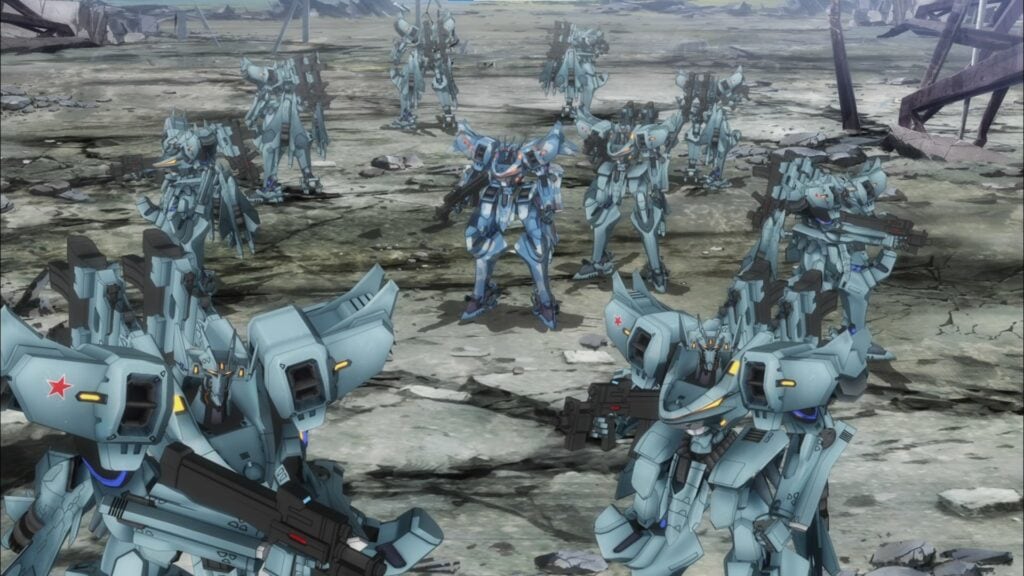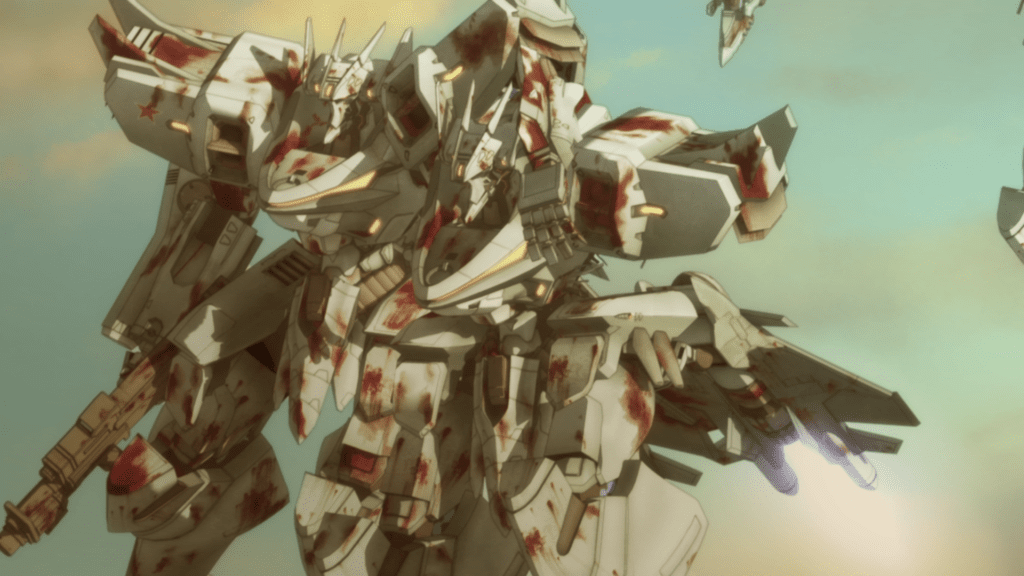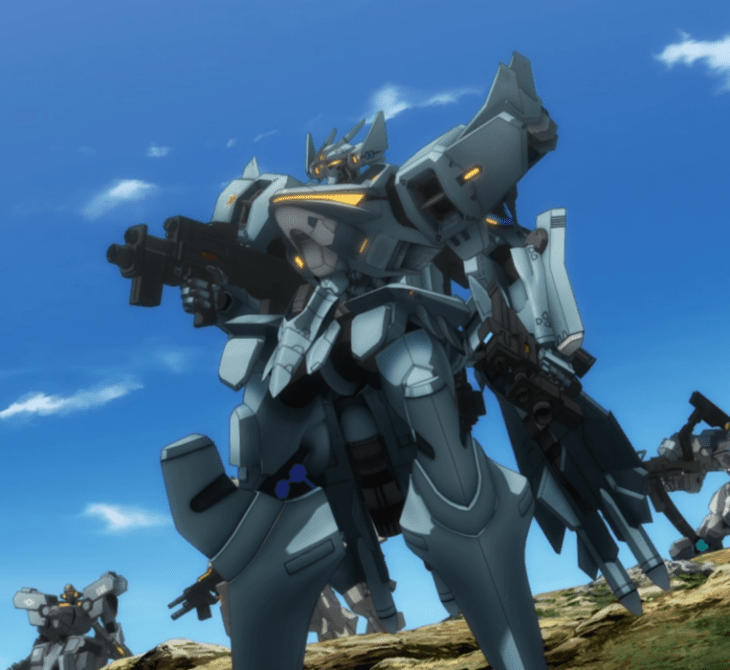
Mecha Profile: Su-27 Zhuravlik – Muv-Luv Alternative
Since the start of the BETA War, Mikoyam Guluvich Design Bureau has been the Soviet’s go-to manufacturer for TSF – showing both highs and lows in their designs. However, after some major letdowns by MIG such as the MiG-23 Cheburashka, MiG-25 Spirt-Voz and MiG-31 Plamya-Lisa, the Communist Party turned to the other major manufacturer – Sufoni – to supply their next mainline craft: the 2nd-generation Su-27 Zhuravlik.

I. Development History:
– Sufoni Design Bureau is a rival company of Mikoyam Guluvich. Their many designs for Soviet forces were rejected such as the Su-11, Su-15 in favor of the MiG-21, Mig-23 from Mikoyam. Their performance were found to be lower and lost the design competition, this put the company in a financial crisis. Thankfully, they were commissioned to produce the F-14AN3 Mindseeker for Alternative III Program. However, this wasn’t a Soviet-based craft, which went against the principle that the Alternative Plan’s host country (Soviet) would supply the TSF, which didn’t really sit well with the Communist Party.
– However, during the production of the F-14AN3, Sufoni received many TSF design knowledge from Grunnan – a U.S TSF manufacturer. Grunnan secretly offered technological knowledge on the F-14 and later on the F-18 Hornet to Sufoni. In addition, Sufoni also received help from Northrock (which later merged with Grunnan to form Northrock Grunnan). With those knowledge, Sufoni developed the 2nd-generation Su-27 Zhuravlik (Су-27 Журавлик). The craft commenced formal deployment in 1992.
– At the time of deployment, The Su-27 faced several stream of minor issues related to its high specifications and due to it being rushed to combat, resulting in its poor reception with Surface Pilots. All the while, Sufoni continued working with Northrock Grunnan in clandestine, and submitted a 3rd-generation version of the Su-27: the Su-37 Terminator. The Su-37 was quickly accepted ahead of schedule, this drove procurement number for the Su-27 down drastically. The craft was used by the famous Soviet’s 211th Tactical Armored Battalion Zhar.
– Even so, Sufoni continued their own refurbishments of the unit, leading to the Su-27SM – the ultimate variation of the craft. This model would achieve high specifications and reliability, which was later praised as a possible rival of the F-15 Eagle. The Soviet also exported the Su-27 to their European Allies and the Indian militaries as well as the Third United Front, the Soviet Union had also actively approached Western countries with their sales pitches.
– Sufoni Design Bureau is a rival company of Mikoyam Guluvich. Their many designs for Soviet forces were rejected such as the Su-11, Su-15 in favor of the MiG-21, Mig-23 from Mikoyam. Their performance were found to be lower and lost the design competition, this put the company in a financial crisis. Thankfully, they were commissioned to produce the F-14AN3 Mindseeker for Alternative III Program. However, this wasn’t a Soviet-based craft, which went against the principle that the Alternative Plan’s host country (Soviet) would supply the TSF, which didn’t really sit well with the Communist Party.
– However, during the production of the F-14AN3, Sufoni received many TSF design knowledge from Grunnan – a U.S TSF manufacturer. Grunnan secretly offered technological knowledge on the F-14 and later on the F-18 Hornet to Sufoni. In addition, Sufoni also received help from Northrock (which later merged with Grunnan to form Northrock Grunnan). With those knowledge, Sufoni developed the 2nd-generation Su-27 Zhuravlik (Су-27 Журавлик). The craft commenced formal deployment in 1992.
– At the time of deployment, The Su-27 faced several stream of minor issues related to its high specifications and due to it being rushed to combat, resulting in its poor reception with Surface Pilots. All the while, Sufoni continued working with Northrock Grunnan in clandestine, and submitted a 3rd-generation version of the Su-27: the Su-37 Terminator. The Su-37 was quickly accepted ahead of schedule, this drove procurement number for the Su-27 down drastically. The craft was used by the famous Soviet’s 211th Tactical Armored Battalion Zhar.
– Even so, Sufoni continued their own refurbishments of the unit, leading to the Su-27SM – the ultimate variation of the craft. This model would achieve high specifications and reliability, which was later praised as a possible rival of the F-15 Eagle. The Soviet also exported the Su-27 to their European Allies and the Indian militaries as well as the Third United Front, the Soviet Union had also actively approached Western countries with their sales pitches.

II. Technical Specs & Armaments:
– The Su-27 Zhuravlik stands at 19.5-meter, utilizing two ALS-31 Jump Units. The Zhuravlik’s name mean “Crane” – but in contrary to its elegant name, the craft is a large craft – taller than F-15, F-16 and F-18 and even the F-14. Even though the size is more than average, its mobility and close quarter capabilities rivaled those of the F-16 Fighting Falcon – a lightweight and high-mobility craft. Later versions of the Su-27 includes a forewing-shaped blade on the side of the Jump Unit’s inlet to increase performance, which wasn’t present on the initial model of the Su-27.
– With the particular demand of the European front as well as the assumed purpose of the craft was to fight in hive interiors, the Su-27 was equipped with many fixed armaments. It is the first TSF to utilized Super-carbon blade vanes across its airframe – most notably on the shoulders, knees and feet. The super carbon blades was intended to slice-n-dice the smaller BETA strains. The most iconic fixed armaments the Zhuravlik has are two “Motor Blade” on both fore-arms – replacements for the combat knives on the Su-27SM version. The Motor Blades are essentially chain-saws. The serrated chain blades’ high rotation speed allow effective cutting through BETAs – especially Grapplers and Tanks. The weapon became iconic for other Sufoni’s later models.
– For ranged armaments, the Zhuravlik uses the Soviet standard A-97 Assault Cannons – which is a simple redesign of the WS-16C that the F-4R used. The Su-27SM also has enhanced fire control system – which bring the craft’s specs to rival that of the strongest 2nd-gen TSF – the F-15 Eagle.
– The head of the Su-27 is unique compared to the MiG-series, which makes it looks like it has 2 distinct eyes while still using visor-styled head equipment suite. The iconic wire-cutter horn of the MiGs have been integrated to the head itself, which gives it a smooth design. The Zhuravlik however has very high power demand due to its fixed armaments, which led to equipment problem in its initial deployment that made Surface Pilots not so fond of the craft.
III. Variants:
Even though the initial model of the Su-27 was produced in low numbers, Sufoni still gave it many upgrades along the line as well as export them to other nation
Even though the initial model of the Su-27 was produced in low numbers, Sufoni still gave it many upgrades along the line as well as export them to other nation
– Su-27 Zhuravlik: The initial production model of the Su-27 with wasn’t too popular with Surface Pilots due to many minor problems.
– Su-27SM: A refurbishment of the Su-27. While the appearances didn’t change, motorized arm blades are included on the fore-arms which became Sufoni’s iconic equipment on future TSF.
– Su-27M2: A 2.5th-generation demonstration craft. The unit incorporate Grunnan’s X-29 design technology such as waist-mounted thruster nozzle to improve aerodynamic.
– Su-27SK: the export version of the Zhuravlik.
– Su-33: Naval variant of the Su-27, with modifications for carrier takeoff/landing capabilities.
– J-11: The United Front of China’s version of the Su-27SK. The manufacturer Chengdu replaced the head module with the iconic round-monitor head module to reduce risk of damage to the sensors. The head module can also use low-tech communication antennas to combat the effect of heavy metal cloud.
– Su-27SM: A refurbishment of the Su-27. While the appearances didn’t change, motorized arm blades are included on the fore-arms which became Sufoni’s iconic equipment on future TSF.
– Su-27M2: A 2.5th-generation demonstration craft. The unit incorporate Grunnan’s X-29 design technology such as waist-mounted thruster nozzle to improve aerodynamic.
– Su-27SK: the export version of the Zhuravlik.
– Su-33: Naval variant of the Su-27, with modifications for carrier takeoff/landing capabilities.
– J-11: The United Front of China’s version of the Su-27SK. The manufacturer Chengdu replaced the head module with the iconic round-monitor head module to reduce risk of damage to the sensors. The head module can also use low-tech communication antennas to combat the effect of heavy metal cloud.
V. Gallery:








Swipe for more:

Mecha Profile: Aquarion Gepard – Aquarion EVOL
The 3rd form of the Aquarion EVOL is a walking artillery of destruction – literally. The Aquarion Gepard has enough firepower to even shoot through dimensions.

Mecha Profile: Aquarion Spada- Aquarion EVOL
The unbeatable melody of the sword – Aquarion Spada is Evol’s 2nd form. With a strong resemblance to a swordsman, the Spada is a key element in unlocking the myths of 12,000 years.

Mecha Profile: Aquarion EVOL – Aquarion EVOL
After 12.000 years, the Mechanical Angel awakens once again. Fighting for the love that span millennia, the Aquarion EVOL once again unlocks the past that was sealed within.

Mecha Profile: NZ-333 Alpha Azieru – Char’s Counterattack
The big and familiar looking NZ-333 α Azieru rumbles the battlefield for the newly formed Neo Zeon. Ironically, it was piloted by a young and naive Newtype girl.

Mecha Profile: MRX-009 Pyscho Gundam
Gundams are already a terrifying sight to see for regular pilots in their mass-produced mobile suits but what if a Gundam gets even larger, stronger and even transformable? The 40-meter Psycho Gundam strikes fear in their eyes.

Mecha Profile: RX-79[G]Ez-8 Gundam Ez8
Some pilots want their Gundam extra thick because they keep getting shot at so instead of dodging, perhaps increasing its armor is a better choice, an armor so thick they were made from the enemies themselves – the Ez8 Gundam.

Mecha Profile: MS-07B-3 Gouf Custom
Oh boy it’s definitely not a Zaku! The Gouf Custom is a fine choice for Zeon’s aces that prefer lighter mobile suits for close quarter combat over the mass-produced Zaku II.

Mecha Profile: MA-08 Big Zam
This iconic and recognizable giant chicken-legged mobile suit – or mobile armor to be exact has made its debut to the Universal Century during One Year War – the Big Zam.

Mecha Profile: RX-78GP03 Gundam Dendrobium
A robot with a gigantic weapon pack on its back is undoubtedly one of the coolest ideas anyone can come up with and the Gundam Dendrobium is here to fulfill everyone’s dream of such. Piloted by the famous carrot hater via ace pilot – Kou Uraki, it soared through war-torn space in the middle of the Delaz Conflict.

Mecha Profile: RX-78GP02 Physalis – Gundam 0083: Stardust Memory
Bulky yet very maneuverable, Gundam Physalis is one big nuclear threat that looms over U.C.0083.

Mecha Profile: RX-78GP01 Zephyranthes – Gundam 0083: Stardust Memory
Flowers that blossom on the battlefield are the strongest kind. The Gp-01 Zephyranthes is a high-mobility Gundam that returned to Gundam’s root with a core fighter.

Mecha Profile: Gundam Z – Hyaku Shiki
An ambitious project to build a Mobile Suit that would last a hundred year. Cladded in a golden color is the Hyaku Shiki – aka Type 100 – which was Lt. Quattro’s personal mobile suit.

Mecha Profile: Gundam ZZ – Qubeley
A machine fitting for the queen of Neo Zeon. The Qubeley is a special machine made for a special pilot. Its funnel dominate the battlefield.

Mecha Profile: Gundam ZZ – ZZ Gundam
Power overwhelming! One of the main Gundam with the highest firepower pre CCA. The ZZ Gundam is an all-in-one combiner that was pivotal in the war against the Neo Zeon.

Mecha Profile: Gundam 0079 – MS-06 Zaku II
The backbone of the Principality of Zeon in the One Year War. The Zaku is not a super prototype, but its reliable performance has brought Zeon many victories – especially when Char Aznable pilot it.




